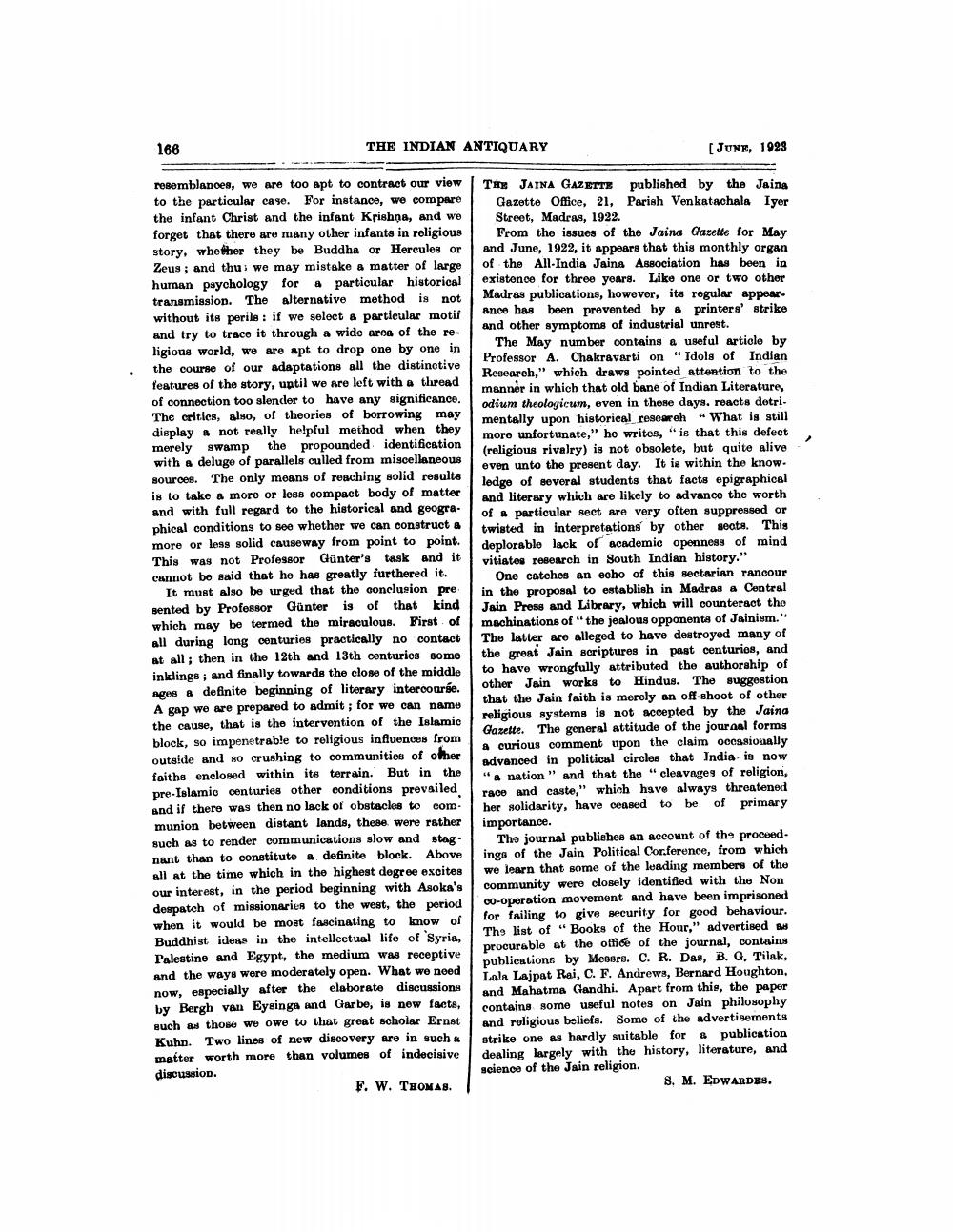________________
166
THE INDIAN ANTIQUARY
resemblances, we are too apt to contract our view to the particular case. For instance, we compare the infant Christ and the infant Krishna, and we forget that there are many other infants in religious story, whether they be Buddha or Hercules or Zeus; and thus we may mistake a matter of large human psychology for a particular historical transmission. The alternative method is not without its perils: if we select a particular motif and try to trace it through a wide area of the religious world, we are apt to drop one by one in the course of our adaptations all the distinctive features of the story, until we are left with a thread of connection too slender to have any significance. The critics, also, of theories of borrowing may display a not really helpful method when they merely swamp the propounded identification with a deluge of parallels culled from miscellaneous sources. The only means of reaching solid results is to take a more or less compact body of matter and with full regard to the historical and geographical conditions to see whether we can construct a more or less solid causeway from point to point. This was not Professor Günter's task and it cannot be said that he has greatly furthered it.
com.
It must also be urged that the conclusion presented by Professor Günter is of that kind which may be termed the miraculous. First of all during long centuries practically no contact at all; then in the 12th and 13th centuries some inklings; and finally towards the close of the middle ages a definite beginning of literary intercourse. A gap we are prepared to admit ; for we can name the cause, that is the intervention of the Islamic block, so impenetrable to religious influences from outside and so crushing to communities of other faiths enclosed within its terrain. But in the pre-Islamic centuries other conditions prevailed and if there was then no lack of obstacles to munion between distant lands, these were rather such as to render communications slow and stagnant than to constitute a definite block. Above all at the time which in the highest degree excites our interest, in the period beginning with Asoka's despatch of missionaries to the west, the period when it would be most fascinating to know of Buddhist ideas in the intellectual life of Syria, Palestine and Egypt, the medium was receptive and the ways were moderately open. What we need now, especially after the elaborate discussions by Bergh van Eysinga and Garbe, is new facts, such as those we owe to that great scholar Ernst Kuhn. Two lines of new discovery are in such a matter worth more than volumes of indecisive discussion.
F. W. THOMAS.
[JUNE, 1923
published by the Jaina Parish Venkatachala Iyer
THE JAINA GAZETTE Gazette Office, 21, Street, Madras, 1922.
From the issues of the Jaina Gazette for May and June, 1922, it appears that this monthly organ of the All-India Jaina Association has been in existence for three years. Like one or two other Madras publications, however, its regular appear. ance has been prevented by a printers' strike and other symptoms of industrial unrest.
The May number contains a useful article by Professor A. Chakravarti on "Idols of Indian Research," which draws pointed attention to the manner in which that old bane of Indian Literature, odium theologicum, even in these days. reacts detri. mentally upon historical research "What is still more unfortunate," he writes, "is that this defect (religious rivalry) is not obsolete, but quite alive even unto the present day. It is within the knowledge of several students that facts epigraphical and literary which are likely to advance the worth of a particular sect are very often suppressed or twisted in interpretations by other seats. This deplorable lack of academic openness of mind vitiates research in South Indian history."
One catches an echo of this sectarian rancour in the proposal to establish in Madras a Central Jain Press and Library, which will counteract the machinations of "the jealous opponents of Jainism." The latter are alleged to have destroyed many of the great Jain scriptures in past centuries, and to have wrongfully attributed the authorship of other Jain works to Hindus. The suggestion that the Jain faith is merely an off-shoot of other religious systems is not accepted by the Jaina Gazette. The general attitude of the journal forms a curious comment upon the claim occasionally advanced in political circles that India is now "a nation" and that the "cleavages of religion, race and caste," which have always threatened her solidarity, have ceased to be of primary importance.
The journal publishes an account of the proceedings of the Jain Political Cor.ference, from which we learn that some of the leading members of the community were closely identified with the Non co-operation movement and have been imprisoned for failing to give security for good behaviour. The list of "Books of the Hour," advertised as procurable at the office of the journal, contains. publications by Messrs. C. R. Das, B. G, Tilak, Lala Lajpat Rai, C. F. Andrews, Bernard Houghton, and Mahatma Gandhi. Apart from this, the paper contains some useful notes on Jain philosophy and religious beliefs. Some of the advertisements strike one as hardly suitable for a publication dealing largely with the history, literature, and science of the Jain religion.
S. M. EDWARDES.




